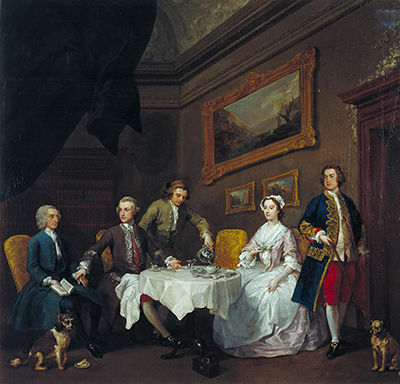William Hogarth was an English painter, who painted a lot of satirical works. His works are generally held to be realistic and hard. He was highly influenced by French and Italian painters of the time.
Hogarth was one of the few artists who became popular and successful during his lifetime and his paintings were often mass-produced as prints for collection. He was also known for creating series of paintings depicting different themes. The Strode Family was one of Hogarth's early paintings, produced in 1738. The painting depicts a group of five people: four men and one woman sitting around a table. They are obviously aristocrats as can be deduced from their clothing. There are two pet dogs as well. On the far left is Dr Arthur Smyth, son of the Bishop of Limerick. Seated next to him is Colonel Samuel Strode, while the woman is Lady Anne. Her husband stands next to her holding the leash of his dog. The butler, Jonathan Powell, is serving them. The other dog is a pug and supposedly belongs to the Colonel. However, it is possible that the pug might be Hogarth's own dog as he loved pugs and also owned one.
The pictures on the wall appear to be by other European artists, reminders of the Grand Tour, that aristocratic young men of the era would undertake before the Napoleonic Wars. Such informal group portraits were typical of his works during this period and they were quite popular. These were known as 'conversation pieces', indicating friends or families in convivial settings. Hogarth painted quite a few of them. Interestingly, it was discovered that the painting had been altered considerably at some point. It is believed that many changes were made to the original painting in order to include William Strode's new wife, Lady Anne Cecil. Of course, this means that several other features also underwent change at the time, including postures, positions, and even the background. For example, the butler was originally positioned farther to the right but was then repositioned in order to make space for painting Lady Anne.
The Strode Family was probably painted on the behest of William Strode, and it passed on to his son, and then the latter's widow. She bequeathed it to her son from another marriage, Reverend William Finch. He was the one who finally bequeathed it to the National Gallery in 1880, on condition that it be taken only after his sister's death. The painting finally entered the National Gallery in 1884 and remained there until it was transferred to the Tate Gallery in 1951, where it still hangs.




